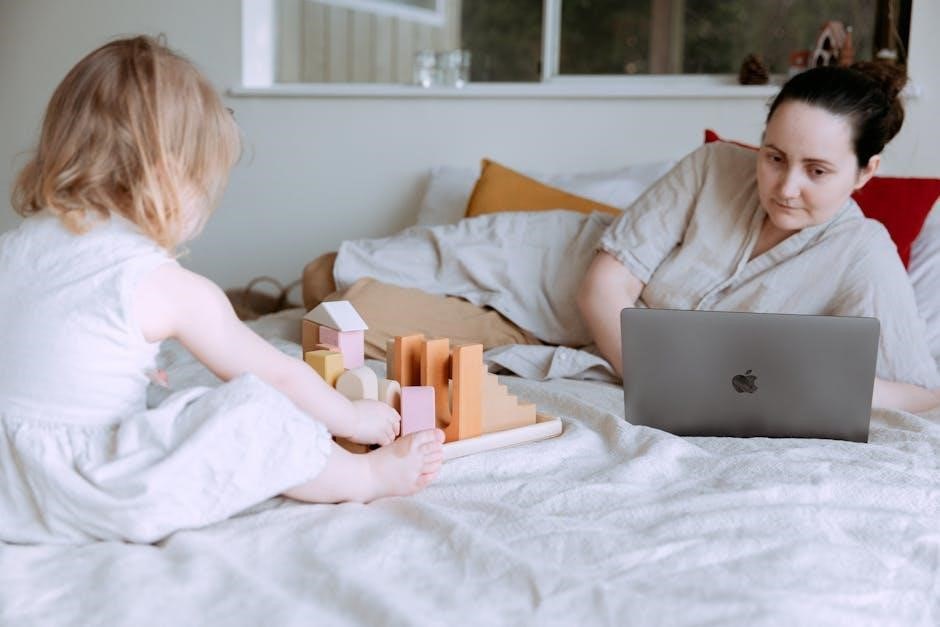Sensory integration is a crucial process where the brain organizes sensory input‚ enabling effective responses to environmental stimuli. It is vital for learning‚ behavior‚ and overall development‚ helping students regulate sensory challenges in educational settings. This section provides foundational knowledge‚ highlighting its significance and practical applications for educators and parents.
What Is Sensory Integration?
Sensory integration refers to the brain’s ability to process and organize sensory information from the environment and the body. It involves integrating inputs from sight‚ sound‚ touch‚ taste‚ smell‚ proprioception (body awareness)‚ and vestibular (balance and movement) systems. This process enables individuals to respond appropriately to stimuli‚ regulate their behavior‚ and engage effectively in daily activities. Sensory integration is crucial for learning‚ motor skills‚ and emotional regulation. When it functions well‚ it supports focus‚ coordination‚ and overall development. For educators and parents‚ understanding sensory integration helps identify and address challenges‚ fostering supportive environments for all students.
The Importance of Sensory Integration in Education
Sensory integration is key to how students process information‚ impacting focus‚ behavior‚ and learning. It enables effective processing of sensory inputs‚ fostering self-regulation and engagement in academic tasks. In educational settings‚ sensory integration supports students in managing distractions‚ completing assignments‚ and interacting socially. For students with sensory processing challenges‚ a supportive sensory environment can significantly enhance their ability to learn. Educators play a critical role in identifying sensory-based difficulties and implementing strategies to create inclusive classrooms. By addressing sensory integration needs‚ teachers can improve academic performance‚ reduce disruptions‚ and promote positive student behaviors.

Practical Strategies for Teachers
Teachers can use sensory tools‚ environmental modifications‚ and structured activities to support students. Techniques like sensory breaks‚ weighted objects‚ and flexible seating promote focus and regulation in classrooms.
Environmental Modifications for Sensory Support
Creating a sensory-friendly classroom involves adjusting lighting‚ seating‚ and noise levels. Use natural light‚ flexible seating options‚ and noise-canceling tools to minimize sensory overload. Incorporate fidget toys‚ tactile materials‚ and visual schedules to provide structure. Designate quiet areas for students needing calm spaces and ensure access to movement breaks. These modifications help regulate sensory experiences‚ fostering a supportive learning environment for all students. By tailoring the classroom environment‚ teachers can address diverse sensory needs effectively‚ promoting focus and engagement.
Activity-Based Strategies to Enhance Sensory Processing
Implementing activity-based strategies can significantly support sensory processing in students. Use tactile exercises‚ such as playdough or finger painting‚ to enhance touch integration. Incorporate movement breaks‚ like stretching or jumping‚ to address vestibular and proprioceptive needs. Sensory bins filled with rice or beans provide hands-on exploration. Auditory activities‚ such as listening games or rhythm exercises‚ can improve sound processing. Visual exercises‚ like puzzles or color sorting‚ also aid in sensory integration. These activities create engaging and structured opportunities for students to process sensory information effectively‚ fostering a balanced and responsive learning environment.
Checklists and Forms for Teachers
Checklists and forms are essential tools for teachers to identify and support sensory challenges. They include practical strategies‚ sensory screening questionnaires‚ and classroom assessment tools to create sensory-friendly environments.
Sensory Integration Screening Questionnaire
The Sensory Integration Screening Questionnaire is a valuable tool for identifying sensory challenges in students. It helps teachers assess how children respond to sensory inputs‚ such as touch‚ sound‚ and movement. By evaluating behaviors like over- or under-reactions‚ educators can pinpoint potential issues early. This questionnaire provides actionable insights‚ enabling tailored strategies to support students’ sensory needs. Regular use fosters inclusive learning environments and enhances academic engagement for all students‚ ensuring they receive the support they need to thrive.
Classroom Sensory Assessment Tools
Classroom Sensory Assessment Tools are essential for identifying sensory challenges and creating supportive learning environments. These tools include checklists‚ forms‚ and questionnaires that help teachers evaluate students’ sensory processing abilities. They assess responses to sensory inputs like touch‚ sound‚ and movement‚ enabling early detection of difficulties. Practical tools‚ such as the Sensory Profile Checklist‚ provide insights into sensory preferences and challenges. By using these assessments‚ educators can develop targeted strategies to enhance sensory integration‚ ensuring students receive the support they need to succeed academically and socially. These resources are invaluable for fostering an inclusive and adaptive classroom setting.

The Role of Occupational Therapy in Sensory Integration
Occupational therapy plays a key role in sensory integration by helping students process sensory information effectively. Therapists assess needs‚ recommend strategies‚ and support teachers in creating adaptive environments‚ fostering student success and participation in daily activities. This collaborative approach ensures personalized interventions that address sensory challenges‚ enhancing learning and overall development. By integrating occupational therapy‚ educators can better support students with sensory processing difficulties‚ promoting an inclusive and effective educational experience.
How Occupational Therapists Can Support Teachers
Occupational therapists assess students’ sensory needs‚ providing tailored strategies to support teachers in creating sensory-friendly environments. They recommend classroom modifications‚ such as flexible seating or sensory tools‚ to enhance student focus and engagement. Therapists also offer professional development‚ equipping teachers with practical techniques to address sensory challenges. By collaborating with educators‚ occupational therapists ensure students receive consistent support‚ fostering academic success and emotional well-being. This partnership bridges the gap between therapeutic interventions and educational practices‚ helping teachers meet diverse student needs effectively.
Collaborative Approaches Between Teachers and Therapists
Collaboration between teachers and occupational therapists is essential for supporting students with sensory challenges. Teachers and therapists can co-assess sensory needs‚ develop personalized sensory diets‚ and implement consistent strategies across home and school. By sharing insights and resources‚ they create a cohesive support system. Therapists provide teachers with practical tools‚ such as checklists and forms‚ to monitor progress and adapt interventions. This teamwork ensures students receive tailored support‚ fostering their ability to focus‚ engage‚ and thrive in the classroom. Effective collaboration enhances both academic and sensory development‚ creating a positive learning environment for all students.

Sensory Diet and Its Benefits
A sensory diet is a tailored plan of activities that help individuals regulate sensory processing. It enhances focus‚ emotional regulation‚ and participation in daily tasks‚ benefiting all students.
What Is a Sensory Diet?
A sensory diet is a personalized plan of activities designed to meet an individual’s sensory needs. It involves structured exercises and environmental adjustments to enhance sensory processing. These activities‚ such as tactile play or movement exercises‚ help regulate sensory input‚ improving focus and emotional regulation. A sensory diet is not a restriction but a proactive approach to support sensory integration‚ ensuring individuals can better respond to their environment. It is often recommended by occupational therapists and can be adapted for use in both home and classroom settings to promote overall well-being and academic performance.
Implementing a Sensory Diet in the Classroom
Implementing a sensory diet in the classroom involves creating a structured plan of sensory activities tailored to students’ needs. Teachers can incorporate tactile exercises‚ movement breaks‚ and sensory-friendly tools like fidgets or weighted blankets. Collaborating with occupational therapists ensures activities align with individual sensory profiles. By integrating these strategies‚ educators can help students regulate sensory input‚ enhancing focus and emotional regulation. A sensory diet fosters an inclusive environment‚ benefiting all learners and promoting academic success. Regular monitoring and adjustments ensure the plan remains effective and responsive to student needs.
Managing Challenging Behaviors Related to Sensory Processing
Identifying triggers and implementing sensory diets or environmental modifications can help reduce challenging behaviors. Proactive strategies‚ such as sensory breaks and structured routines‚ support students’ sensory needs effectively.
Identifying Triggers and Proactive Strategies
Recognizing sensory triggers is key to addressing challenging behaviors. Common triggers include loud noises‚ bright lights‚ or unexpected changes in routine. Proactive strategies such as sensory breaks‚ structured schedules‚ and environmental modifications can minimize these triggers. Teachers can use sensory integration checklists to identify specific challenges and develop personalized interventions. Creating a sensory-friendly classroom environment and encouraging open communication with students helps in understanding their needs. By addressing triggers early‚ educators can reduce disruptions and foster a supportive learning atmosphere for all students. Regular collaboration with occupational therapists also enhances the effectiveness of these strategies.
Behavioral Interventions for Sensory-Driven Behaviors
Behavioral interventions for sensory-driven behaviors focus on helping students manage sensory-related challenges. Strategies include sensory breaks‚ structured activities‚ and positive reinforcement. Teachers can provide tactile or deep pressure activities to calm overstimulated students. Using visual schedules and clear expectations helps reduce sensory-related anxiety. Incorporating movement breaks and sensory-friendly tools‚ like fidgets or weighted blankets‚ can also support regulation. Collaborating with occupational therapists ensures interventions align with individual needs. These proactive approaches help students develop self-regulation skills‚ reducing sensory-driven behaviors and improving classroom engagement. Tailoring interventions to each student’s specific triggers fosters a more inclusive and supportive learning environment.

Resources and Further Reading
Explore recommended books like Answers to Questions Teachers Ask About Sensory Integration and Sensory Processing Explained. Utilize checklists‚ PDF guides‚ and online webinars for deeper understanding.
Recommended Books and PDF Guides
Key resources include Answers to Questions Teachers Ask About Sensory Integration by Carol Kranowitz‚ offering practical tools and strategies. The Sensory Processing Disorder Answer Book provides insights into common challenges. Free PDF guides like the Sensory Integration Screening Questionnaire and Sensory Profile Checklist are invaluable for assessments. These resources equip educators with actionable approaches to support students with sensory processing needs‚ ensuring inclusive and effective learning environments. They also complement occupational therapy practices and sensory diets‚ making them essential for both teachers and parents seeking to understand and address sensory integration challenges.
Online Courses and Webinars for Teachers
Online courses and webinars provide teachers with accessible training on sensory integration. Platforms offer free and paid resources‚ such as the webinar Sensory Integration Therapy Done Right‚ which covers practical strategies for sensory processing. Courses like Sensory Processing Explained offer insights into identifying and addressing sensory challenges. These resources often include downloadable guides‚ checklists‚ and tools to support classroom implementation. They are designed to help educators create sensory-friendly environments and collaborate effectively with occupational therapists. Many courses are tailored for busy teachers‚ providing flexible learning opportunities to enhance their understanding and application of sensory integration principles in education.